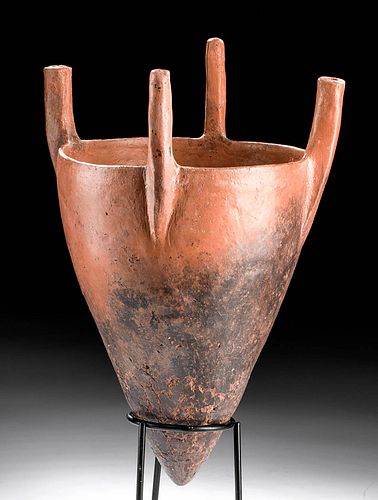Rare Anatolian Terracotta Libation Vessel, TL Tested
Lot 65f
About Seller
Artemis Gallery
686 S Taylor Ave, Ste 106
Louisville, CO 80027
United States
Selling antiquities, ancient and ethnographic art online since 1993, Artemis Gallery specializes in Classical Antiquities (Egyptian, Greek, Roman, Near Eastern), Asian, Pre-Columbian, African / Tribal / Oceanographic art. Our extensive inventory includes pottery, stone, metal, wood, glass and textil...Read more
Categories
Estimate:
$14,000 - $20,000
Absentee vs Live bid
Two ways to bid:
- Leave a max absentee bid and the platform will bid on your behalf up to your maximum bid during the live auction.
- Bid live during the auction and your bids will be submitted real-time to the auctioneer.
Bid Increments
| Price | Bid Increment |
|---|---|
| $0 | $25 |
| $300 | $50 |
| $1,000 | $100 |
| $2,000 | $250 |
| $5,000 | $500 |
| $10,000 | $1,000 |
| $20,000 | $2,500 |
| $50,000 | $5,000 |
| $100,000 | $10,000 |
| $200,000 | $20,000 |
About Auction
By Artemis Gallery
Feb 13, 2020
Set Reminder
2020-02-13 10:00:00
2020-02-13 10:00:00
America/New_York
Bidsquare
Bidsquare : Exceptional Antiquities, Asian, Ethnographic
https://www.bidsquare.com/auctions/artemis-gallery/exceptional-antiquities-asian-ethnographic-4848
An important one-day auction featuring museum-worthy examples of Egyptian, Greek, Roman, Etruscan, Near Eastern, Far East / Asian, Pre-Columbian, African / Tribal, Oceanic, Native American, Spanish Colonial, Russian, Fossils, Ancient Jewelry, Fine Art, so much more! Artemis Gallery info@artemisgallery.com
An important one-day auction featuring museum-worthy examples of Egyptian, Greek, Roman, Etruscan, Near Eastern, Far East / Asian, Pre-Columbian, African / Tribal, Oceanic, Native American, Spanish Colonial, Russian, Fossils, Ancient Jewelry, Fine Art, so much more! Artemis Gallery info@artemisgallery.com
- Lot Description
Ancient Near East / Central Asia, Anatolia, early Bronze Age, ca. late 3rd to 2nd millennium BCE. A fabulous and rare example of a hand-built terracotta libation vessel presenting a tall, conical form with a tapered base, an expanding midsection, and a thick rim surrounded by four rod-shaped handles. The tops of two handles bear shallow, vertical perforations that were perhaps used for inverting the vessel to dry or for inserting an additional implement that straddled above the vessel's gaping mouth. Vessels like this example are incredibly rare due to the fragility of Anatolian terracotta, and even fragmentary vessels are still highly prized among collectors. Though the function of the handle perforations is unknown, the sheer size of this vessel suggests it was used for ceremonies and rituals of symbolic importance as most other libation vessels are much smaller in size. A fine example of ancient Anatolian artistry! Size: 8.75" W x 12.5" H (22.2 cm x 31.8 cm); 13.8" H (35.1 cm) on included custom stand.
This piece has been tested using thermoluminescence (TL) analysis and has been found to be ancient and of the period stated. A full report will accompany purchase.
Provenance: ex-private prominent D.K. collection, New York, USA, acquired in the 2000s
All items legal to buy/sell under U.S. Statute covering cultural patrimony Code 2600, CHAPTER 14, and are guaranteed to be as described or your money back.
A Certificate of Authenticity will accompany all winning bids.
We ship worldwide and handle all shipping in-house for your convenience.
#153103Repaired from multiple pieces, with restoration to areas of body and legs, and resurfacing and overpainting along new material and break lines. Minor abrasions and nicks to legs, body, and conical base, with fading to original pigmentation and areas of fire-darkening, and light encrustations. Light earthen deposits and nice traces of original pigment throughout. Two TL drill holes: inside one perforated leg, and beneath conical base.Condition
- Shipping Info
-
All shipping is handled in-house for your convenience. Your invoice from Artemis Gallery will include shipping calculation instructions. If in doubt, please inquire BEFORE bidding for estimated shipping costs for individual items.
-
- Buyer's Premium



 EUR
EUR CAD
CAD AUD
AUD GBP
GBP MXN
MXN HKD
HKD CNY
CNY MYR
MYR SEK
SEK SGD
SGD CHF
CHF THB
THB















